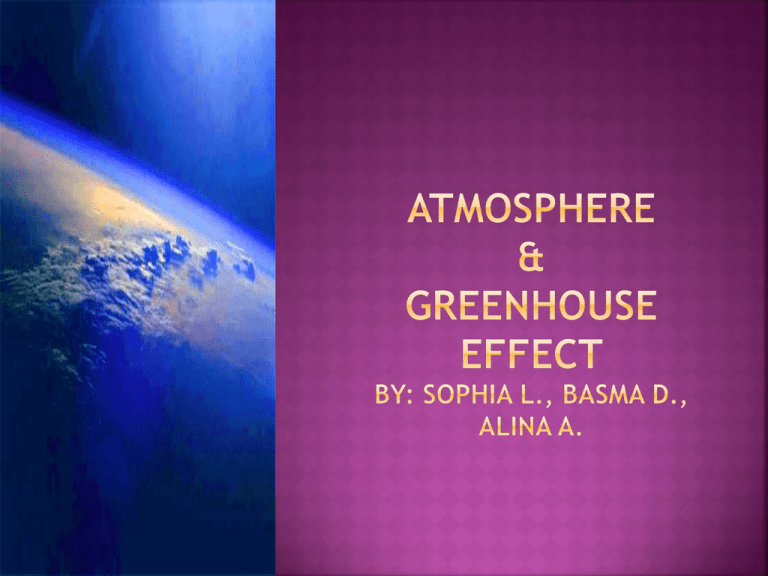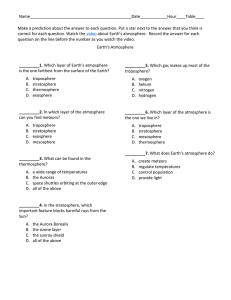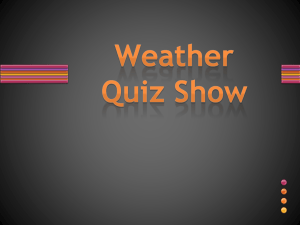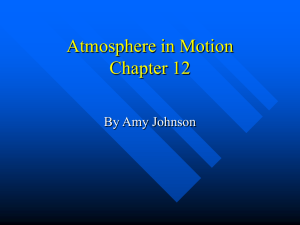atmosphere.pptx
advertisement

Atmosphere is a layer of gasses surrounding the earth The atmosphere is made up of oxygen, nitrogen, argon carbon dioxide, some of helium, hydrogen, ozone gasses and water vapour dust particles. Atmosphere protects the life on earth by absorbing ultraviolet solar radiation. Without atmosphere life wouldn’t exist on earth. Atmosphere warms up the earth by the process of green house effect. It helps reduce the extreme temperatures between day and night. 5 layers determined by whether temperature increases or decreases with altitude. From highest to lowest, these layers are: Exosphere: The exosphere is the uppermost layer of the atmosphere. Thermosphere: The thermosphere is the biggest of all the layers of the earth's atmosphere directly above the mesosphere and directly below the exosphere. International space station orbits in this layer. Mesosphere: The mesosphere extends from the stratopause to 80– 85km (260,000–280,000 ft). It is the layer where most meteors burn up upon entering the atmosphere. Stratosphere: The stratosphere is the second major layer of Earth's atmosphere, just above the troposphere, and below the mesosphere. Troposphere: The troposphere begins at the surface and extends to between 7 km (23,000 ft) at the poles Ozone layer protects the earth from harmful rays from the sun It protects life Ozone gases exist in the stratosphere. Absorption of UV radiation. Photochemical smog in troposphere. Emission test on cars every two years. Definition: A natural process whereby gases and clouds absorb infrared radiation emitted from the Earth’s surface and radiates it, heating the atmosphere and Earth’s surface. The greenhouse effect is the rise in temperature that the Earth experiences because certain gases in the atmosphere (water vapour, carbon dioxide, nitrous oxide, and methane, for example) trap energy from the sun. Without these gases, heat would escape back into space and Earth’s average temperature would be about 60ºF colder. Because of how they warm our world, these gases are referred to as greenhouse gases. 1. Carpooling 2. Turn of the lights if you are not using them. 3. Unplug cords if they are not in use. 4. Reuse, Reduce, and Recycle 5. Do not litter! Dispose garbage in a correct manner. 6. Compost 7. Use fluorescent light bulbs, they use less energy! 8. Participate in the Earth hour! Save energy 9. Use stainless steel instead of plastic bottles. 10. Take a shower, rather than a bath. 11. Walk to school. 12. Don’t waste tap water. If you are not using it, turn off the tap. 13. Don’t throw away your toys, give them to local charities. 14. Buy organic! 15. Use reusable bags when you go grocery shopping. Weather State of the atmosphere, including temperature, precipitation, wind, and humidity in a particular location over a short period of time. Climate The average of the weather in a region over a long period of time. Climate Change is the change in the statistical distribution of weather over periods of time, that ranges from decades to millions of years. Climate change can be limited to a specific region or it may occur across the whole earth. Earths climate changing again in to what they call Global Warming Scientist have studied the evidence of climate change Rising Temperature Changes in Serve Weather Changes in Precipitation Patterns Changes in Seasons Changes in Ecosystems Melting Ice Rising Sea Level o o o Rising Temperature Temperature records around the world since the late 1800’s have been studied Earths average temperature has gradually increased since then Northern and Southern Hemispheres temperatures dropping o o o Changes in Serve Weather More serve weather events such as hurricanes and heat waves 2003 hottest summer ever recorded in Europe More hurricanes due to warmer ocean temperatures Heat Wave in Europe in 2003 More rainfalls than snowfalls in the Northern Hemisphere Total annual precipitation increase in northern countries Total annual precipitation decrease in southern countries • • • • Season shifting Decrease in the amount of average cold days Winter season arriving earlier, and ending earlier Longer growing seasons Animals and plants affected by the shifts in temperature and precipitation Plants flowering earlier Animals breeding earlier Animals and plants have to migrate up north Glaciers decreasing in size Melting ice-sheets in Greenland, Antarctica, and The Arctic Melting snow in Antarctica No ice in The Arctic within the next few year • • • Sea level rising twice as fast since 1993 Small Islands disappear due to the rise of sea level Devastating floods occur in low-lying countries Global Average Sea Level Florida State, dark blue represents a 5 meter raise in sea level and light blue represents a 10 raise in sea level. 1. 2. 3. 4. 5. 6. What is the greenhouse effect? What are the 5 layers of the atmosphere? (Name them in order) Name 3 evident of climate change. What is photo-chemical smog? Where did the heat wave in 2003 occur? Name 5 ways you could prevent greenhouse gas effects. What is the greenhouse effect? A natural process whereby gases and clouds absorb infrared radiation emitted from the Earth’s surface and radiates it, heating the atmosphere and Earth’s surface. What are the 5 layers of the atmosphere? (Name them in order) 1. Troposphere 2. Stratosphere 3. Mesosphere 4. Thermosphere 5. Exosphere Name 3 evident of climate change. Of the 7: rising temperature, changes in severe weather, changes in precipitation patterns, changes in season, changes in ecosystem, melting ice, rising sea levels. What is photo-chemical smog? Mixture of sun rays and car emissions. Where did the heat wave in 2003 occur? All over Europe. Name 5 ways you could prevent greenhouse gas effects. Of the 15 ways to prevent greenhouse gas effects.





